Aggregation Methods Based on Quality Model Assessment for Federated Learning Applications: Overview and Comparative Analysis
Abstract
:1. Introduction
- A detailed discussion of the benefits and limitations resulting from using local models’ accuracy in the aggregation step with a focus on our methods: FedAcc and FedAccSize [25];
- The design of a new aggregation method, FedLasso, which enhances the assessment of local models’ quality by applying Lasso regression, where the resulting Lasso coefficients are exploited for parameter-level aggregation;
2. Related Works
3. Aggregation of Local Models in Federated Learning
| Algorithm 1 Aggregation methods: FedAvg and FedAvgM |
|
4. Aggregation Based on Local Models’ Quality Assessment
4.1. Examination of FedAcc and FedAccSize
| Algorithm 2 Aggregation methods: FedAcc and FedAccSize |
|
4.2. Description of FedLasso
| Algorithm 3 Intermediary coefficients: FedLasso |
|
5. Experimental Design and Illustrative Results
5.1. Data Sets Used for Experimental Investigations
5.2. Federated Learning Settings and Experiment Design
5.3. Results Analysis
5.4. Ablation Study
6. Conclusions
Author Contributions
Funding
Institutional Review Board Statement
Informed Consent Statement
Data Availability Statement
Conflicts of Interest
References
- McMahan, B.; Moore, E.; Ramage, D.; Hampson, S.; Arcas, B.A. Communication-efficient learning of deep networks from decentralized data. In Proceedings of the Artificial Intelligence and Statistics, PMLR, Fort Lauderdale, FL, USA, 20–22 April 2017; pp. 1273–1282. [Google Scholar]
- Konečný, J.; McMahan, H.B.; Yu, F.X.; Richtarik, P.; Suresh, A.T.; Bacon, D. Federated Learning: Strategies for Improving Communication Efficiency. In Proceedings of the NIPS Workshop on Private Multi-Party Machine Learning, Barcelona, Spain, 9 December 2016. [Google Scholar]
- Wen, J.; Zhang, Z.; Lan, Y.; Cui, Z.; Cai, J.; Zhang, W. A survey on federated learning: Challenges and applications. Int. J. Mach. Learn. Cybern. 2023, 14, 513–535. [Google Scholar] [PubMed]
- Chen, Y.; Qin, X.; Wang, J.; Yu, C.; Gao, W. Fedhealth: A federated transfer learning framework for wearable healthcare. IEEE Intell. Syst. 2020, 35, 83–93. [Google Scholar] [CrossRef]
- Rieke, N.; Hancox, J.; Li, W.; Milletari, F.; Roth, H.R.; Albarqouni, S.; Bakas, S.; Galtier, M.N.; Landman, B.A.; Maier-Hein, K.; et al. The future of digital health with federated learning. NPJ Digit. Med. 2020, 3, 119. [Google Scholar] [PubMed]
- Yang, T.; Andrew, G.; Eichner, H.; Sun, H.; Li, W.; Kong, N.; Ramage, D.; Beaufays, F. Applied federated learning: Improving google keyboard query suggestions. arXiv 2018, arXiv:1812.02903. [Google Scholar]
- Li, Y.; Tao, X.; Zhang, X.; Liu, J.; Xu, J. Privacy-preserved federated learning for autonomous driving. IEEE Trans. Intell. Transp. Syst. 2021, 23, 8423–8434. [Google Scholar] [CrossRef]
- Wasilewska, M.; Bogucka, H.; Poor, H.V. Secure Federated Learning for Cognitive Radio Sensing. IEEE Commun. Mag. 2023, 61, 68–73. [Google Scholar]
- Barbieri, L.; Savazzi, S.; Brambilla, M.; Nicoli, M. Decentralized federated learning for extended sensing in 6G connected vehicles. Veh. Commun. 2022, 33, 100396. [Google Scholar] [CrossRef]
- Yang, Q.; Liu, Y.; Chen, T.; Tong, Y. Federated machine learning: Concept and applications. ACM Trans. Intell. Syst. Technol. (TIST) 2019, 10, 1–19. [Google Scholar]
- Feng, C.; Liu, B.; Yu, K.; Goudos, S.K.; Wan, S. Blockchain-empowered decentralized horizontal federated learning for 5G-enabled UAVs. IEEE Trans. Ind. Inform. 2021, 18, 3582–3592. [Google Scholar] [CrossRef]
- Wei, K.; Li, J.; Ma, C.; Ding, M.; Wei, S.; Wu, F.; Chen, G.; Ranbaduge, T. Vertical Federated Learning: Challenges, Methodologies and Experiments. arXiv 2022, arXiv:2202.04309. [Google Scholar]
- Li, L.; Fan, Y.; Tse, M.; Lin, K.Y. A review of applications in federated learning. Comput. Ind. Eng. 2020, 149, 106854. [Google Scholar] [CrossRef]
- Yuan, L.; Sun, L.; Yu, P.S.; Wang, Z. Decentralized Federated Learning: A Survey and Perspective. arXiv 2023, arXiv:2306.01603. [Google Scholar]
- Li, T.; Sahu, A.K.; Zaheer, M.; Sanjabi, M.; Talwalkar, A.; Smith, V. Federated optimization in heterogeneous networks. Proc. Mach. Learn. Syst. 2020, 2, 429–450. [Google Scholar]
- Zhou, Z.; Sun, F.; Chen, X.; Zhang, D.; Han, T.; Lan, P. A Decentralized Federated Learning Based on Node Selection and Knowledge Distillation. Mathematics 2023, 11, 3162. [Google Scholar] [CrossRef]
- Rodríguez-Barroso, N.; Jiménez-López, D.; Luzón, M.V.; Herrera, F.; Martínez-Cámara, E. Survey on federated learning threats: Concepts, taxonomy on attacks and defences, experimental study and challenges. Inf. Fusion 2023, 90, 148–173. [Google Scholar] [CrossRef]
- Zhang, C.; Xie, Y.; Bai, H.; Yu, B.; Li, W.; Gao, Y. A survey on federated learning. Knowl.-Based Syst. 2021, 216, 106775. [Google Scholar] [CrossRef]
- Mu, X.; Shen, Y.; Cheng, K.; Geng, X.; Fu, J.; Zhang, T.; Zhang, Z. Fedproc: Prototypical contrastive federated learning on non-iid data. Future Gener. Comput. Syst. 2023, 143, 93–104. [Google Scholar] [CrossRef]
- Park, J.; Yoon, D.; Yeo, S.; Oh, S. AMBLE: Adjusting mini-batch and local epoch for federated learning with heterogeneous devices. J. Parallel Distrib. Comput. 2022, 170, 13–23. [Google Scholar] [CrossRef]
- Zhu, C.; Zhang, J.; Sun, X.; Chen, B.; Meng, W. ADFL: Defending Backdoor Attacks in Federated Learning via Adversarial Distillation. Comput. Secur. 2023, 132, 103366. [Google Scholar] [CrossRef]
- Li, A.; Sun, J.; Zeng, X.; Zhang, M.; Li, H.; Chen, Y. Fedmask: Joint computation and communication-efficient personalized federated learning via heterogeneous masking. In Proceedings of the 19th ACM Conference on Embedded Networked Sensor Systems, Coimbra, Portugal, 15–17 November 2021; pp. 42–55. [Google Scholar]
- Wu, J.; Wang, Y.; Shen, Z.; Liu, L. Adaptive client and communication optimizations in Federated Learning. Inf. Syst. 2023, 116, 102226. [Google Scholar] [CrossRef]
- Ma, C.; Li, J.; Ding, M.; Yang, H.H.; Shu, F.; Quek, T.Q.; Poor, H.V. On safeguarding privacy and security in the framework of federated learning. IEEE Netw. 2020, 34, 242–248. [Google Scholar] [CrossRef]
- Bejenar, I.; Ferariu, L.; Pascal, C.; Caruntu, C.F. FedAcc and FedAccSize: Aggregation Methods for Federated Learning Applications. In Proceedings of the 2023 31st Mediterranean Conference on Control and Automation (MED), IEEE, Limassol, Cyprus, 26–29 June 2023; pp. 593–598. [Google Scholar]
- Hsu, H.; Qi, H.; Brown, M. Measuring the Effects of Non-Identical Data Distribution for Federated Visual Classification. arXiv 2019, arXiv:1909.06335. [Google Scholar]
- Guo, J.; Liu, Z.; Tian, S.; Huang, F.; Jiaxing Li, X.L.; Igorevich, K.K.; Ma, J. TFL-DT: A Trust Evaluation Scheme for Federated Learning in Digital Twin for Mobile Networks. IEEE J. Sel. Areas Commun. 2023, 41, 3548–3560. [Google Scholar] [CrossRef]
- Pasquier, T.F.J.M.; Singh, D.E.J.; Bacon, J. CamFlow: Managed Data-sharing for Cloud Services. IEEE Trans. Cloud Comput. 2023, 5, 472–484. [Google Scholar] [CrossRef]
- Stergiou, C.L.; Psannis, K.E.; Gupta, B.B. InFeMo: Flexible Big Data management through a federated Cloud system. ACM Trans. Internet Technol. 2021, 22, 1–22. [Google Scholar] [CrossRef]
- Wang, H.; Yurochkin, M.; Sun, Y.; Papailiopoulos, D.; Khazaeni, Y. Federated learning with matched averaging. arXiv 2020, arXiv:2002.06440. [Google Scholar]
- Palihawadana, C.; Wiratunga, N.; Wijekoon, A.; Kalutarage, H. FedSim: Similarity guided model aggregation for Federated Learning. Neurocomputing 2022, 483, 432–445. [Google Scholar] [CrossRef]
- Bagdasaryan, E.; Veit, A.; Hua, Y.; Estrin, D.; Shmatikov, V. How to backdoor federated learning. In Proceedings of the International Conference on Artificial Intelligence and Statistics, PMLR, Online, 26–28 August 2020; pp. 2938–2948. [Google Scholar]
- Rodríguez-Barroso, N.; Martínez-Cámara, E.; Luzón, M.V.; Herrera, F. Dynamic defense against byzantine poisoning attacks in federated learning. Future Gener. Comput. Syst. 2022, 133, 1–9. [Google Scholar] [CrossRef]
- Yurochkin, M.; Agarwal, M.; Ghosh, S.; Greenewald, K.; Hoang, N.; Khazaeni, Y. Bayesian nonparametric federated learning of neural networks. In Proceedings of the International Conference on Machine Learning, PMLR, Long Beach, CA, USA, 9–15 June 2019; pp. 7252–7261. [Google Scholar]
- Chen, H.Y.; Chao, W.L. Fedbe: Making bayesian model ensemble applicable to federated learning. arXiv 2020, arXiv:2009.01974. [Google Scholar]
- Czajkowski, M.; Jurczuk, K.; Kretowski, M. Steering the interpretability of decision trees using lasso regression-an evolutionary perspective. Inf. Sci. 2023, 638, 118944. [Google Scholar] [CrossRef]
- Fan, Y.; Tao, B.; Zheng, Y.; Jang, S.S. A data-driven soft sensor based on multilayer perceptron neural network with a double LASSO approach. IEEE Trans. Instrum. Meas. 2019, 69, 3972–3979. [Google Scholar] [CrossRef]
- Coelho, F.; Costa, M.; Verleysen, M.; Braga, A.P. LASSO multi-objective learning algorithm for feature selection. Soft Comput. 2020, 24, 13209–13217. [Google Scholar] [CrossRef]
- Kashima, T.; Kishida, I.; Amma, A.; Nakayama, H. Server Aggregation as Linear Regression: Reformulation for Federated Learning. 2022. Available online: https://openreview.net/pdf?id=kV0cA81Vau (accessed on 30 August 2023).
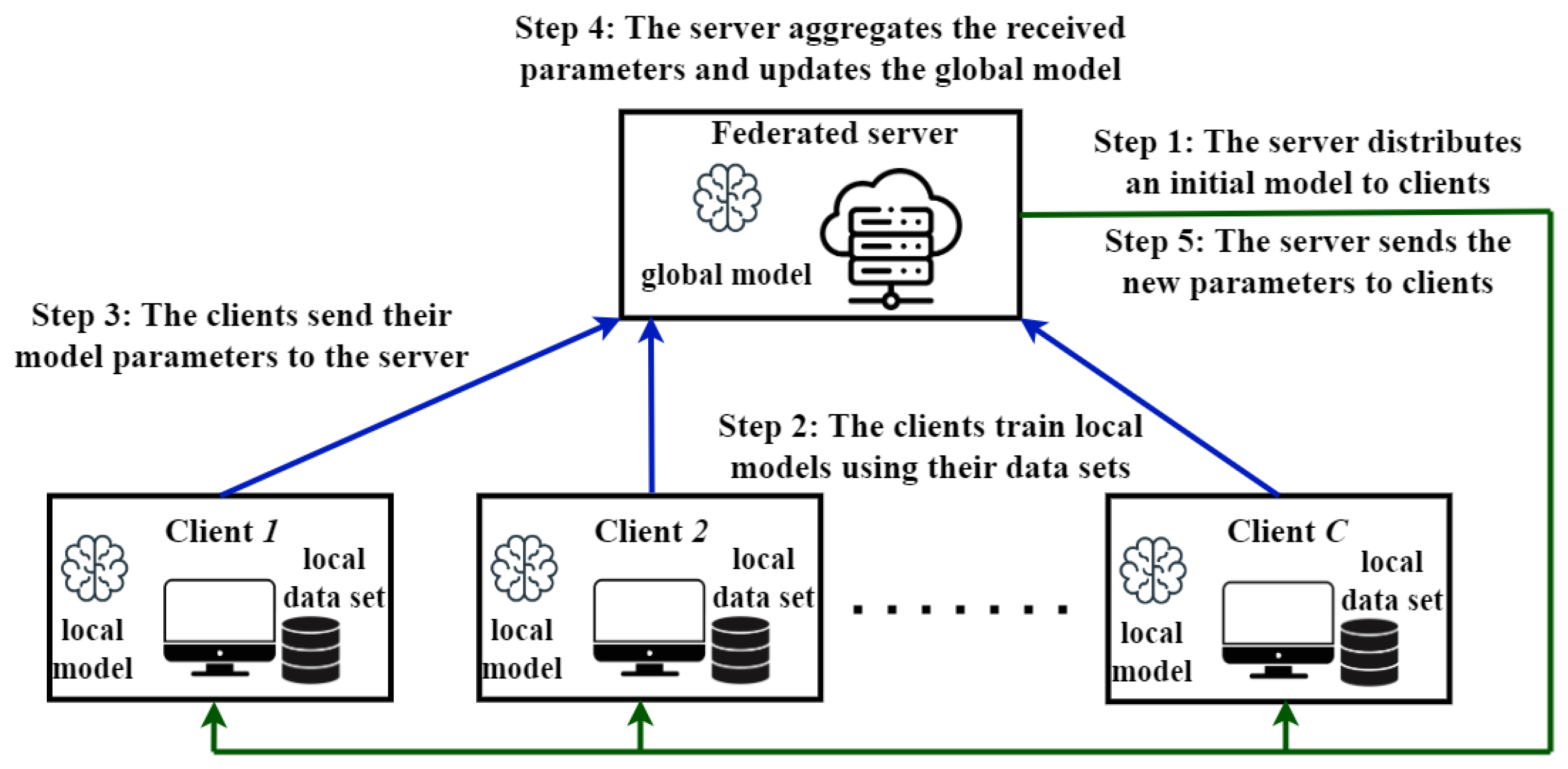




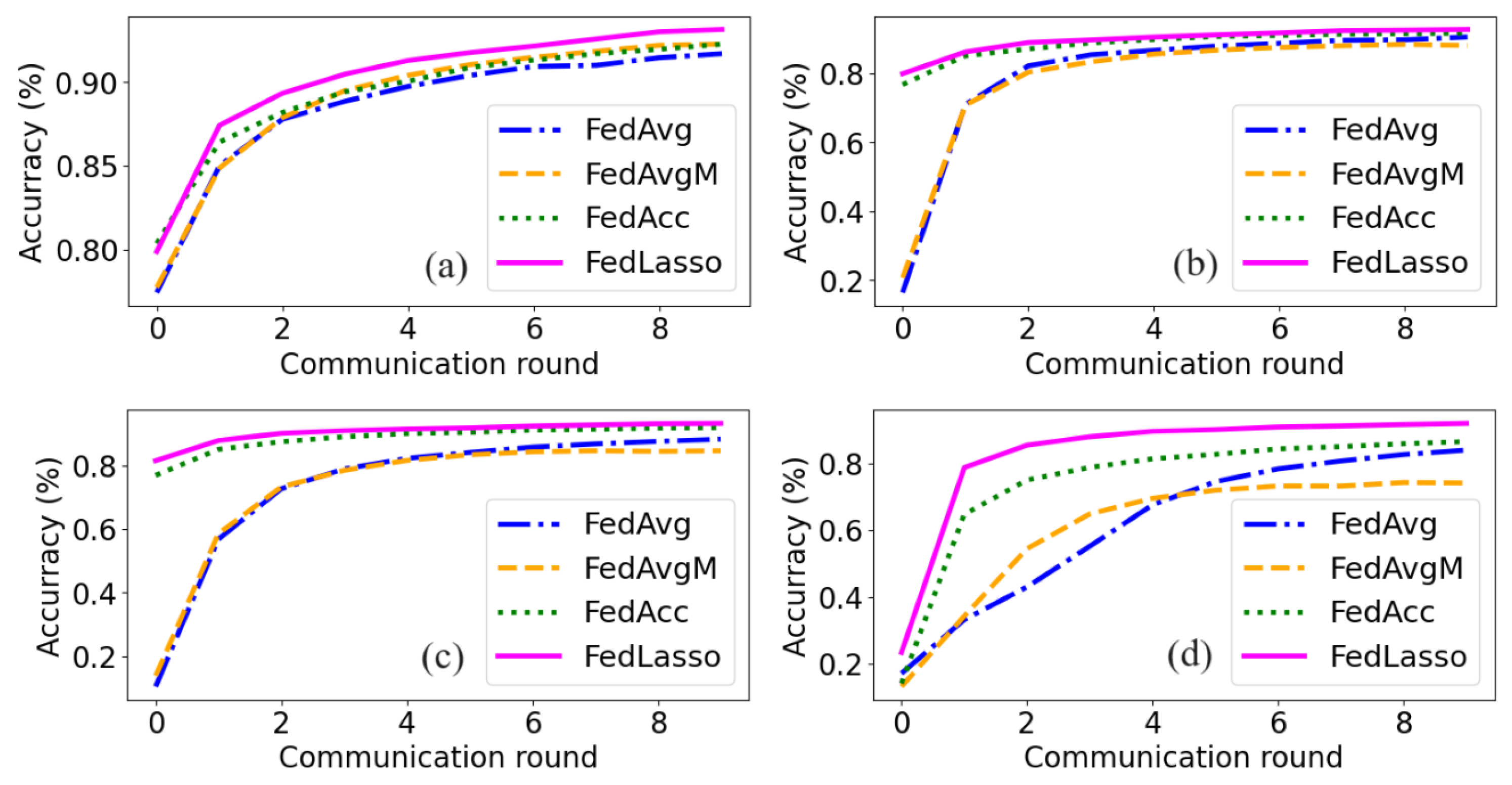
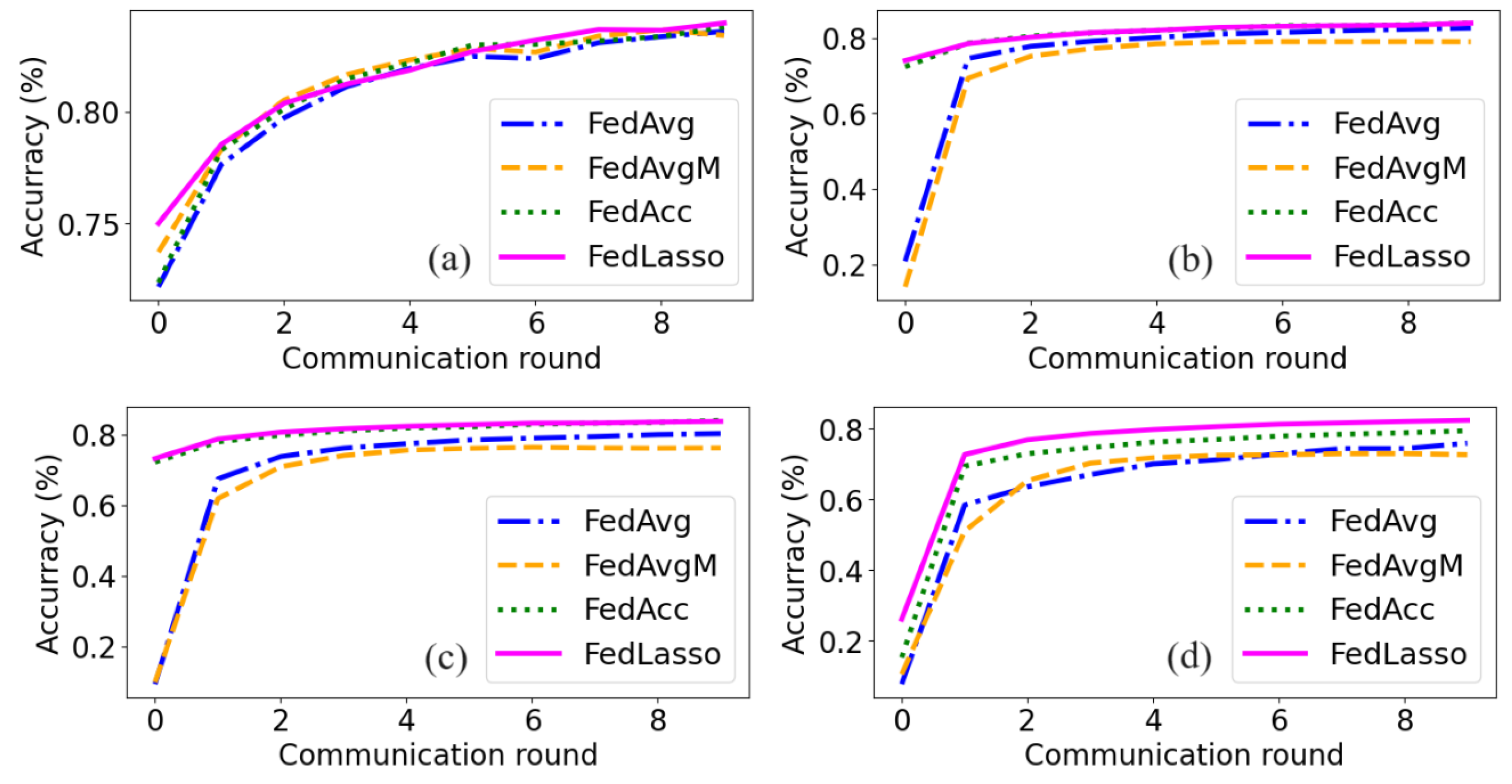
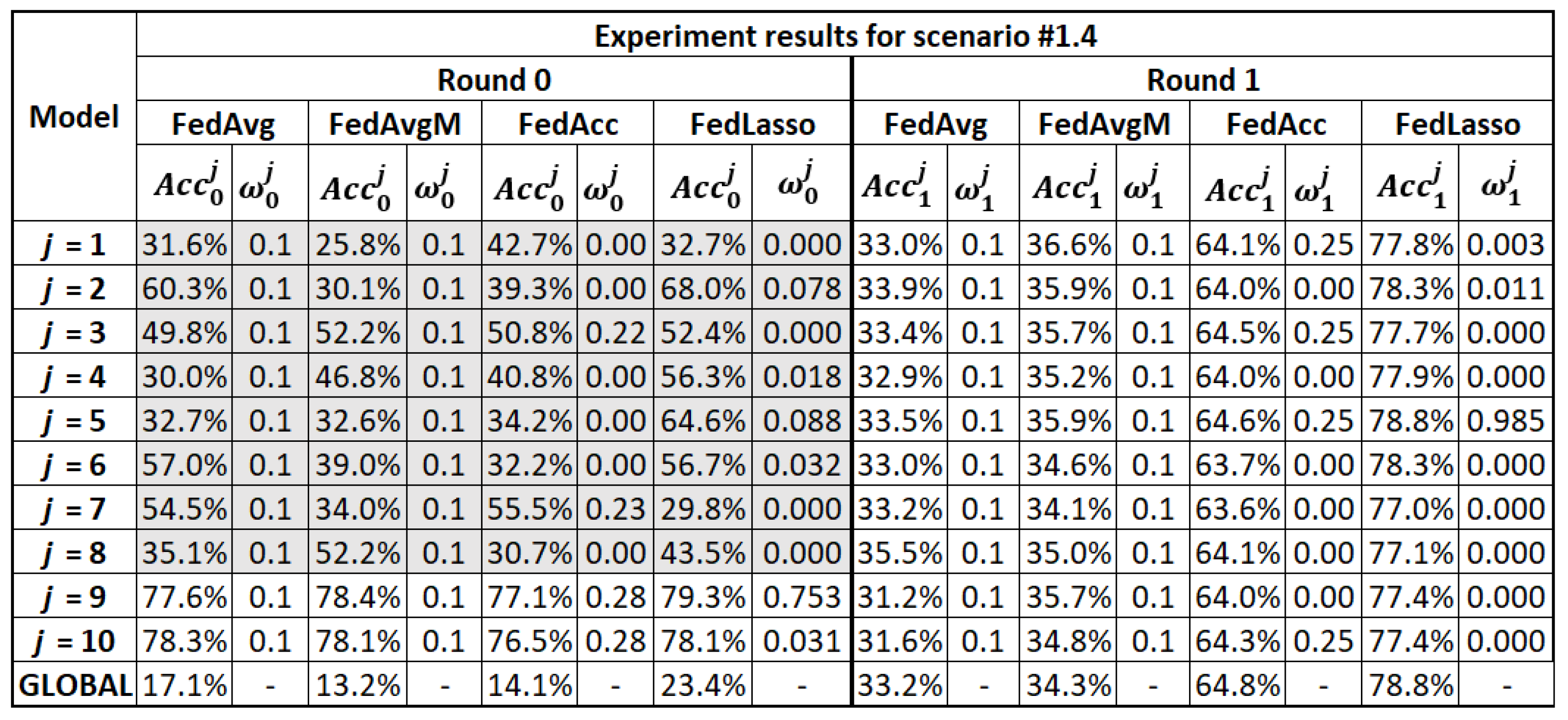



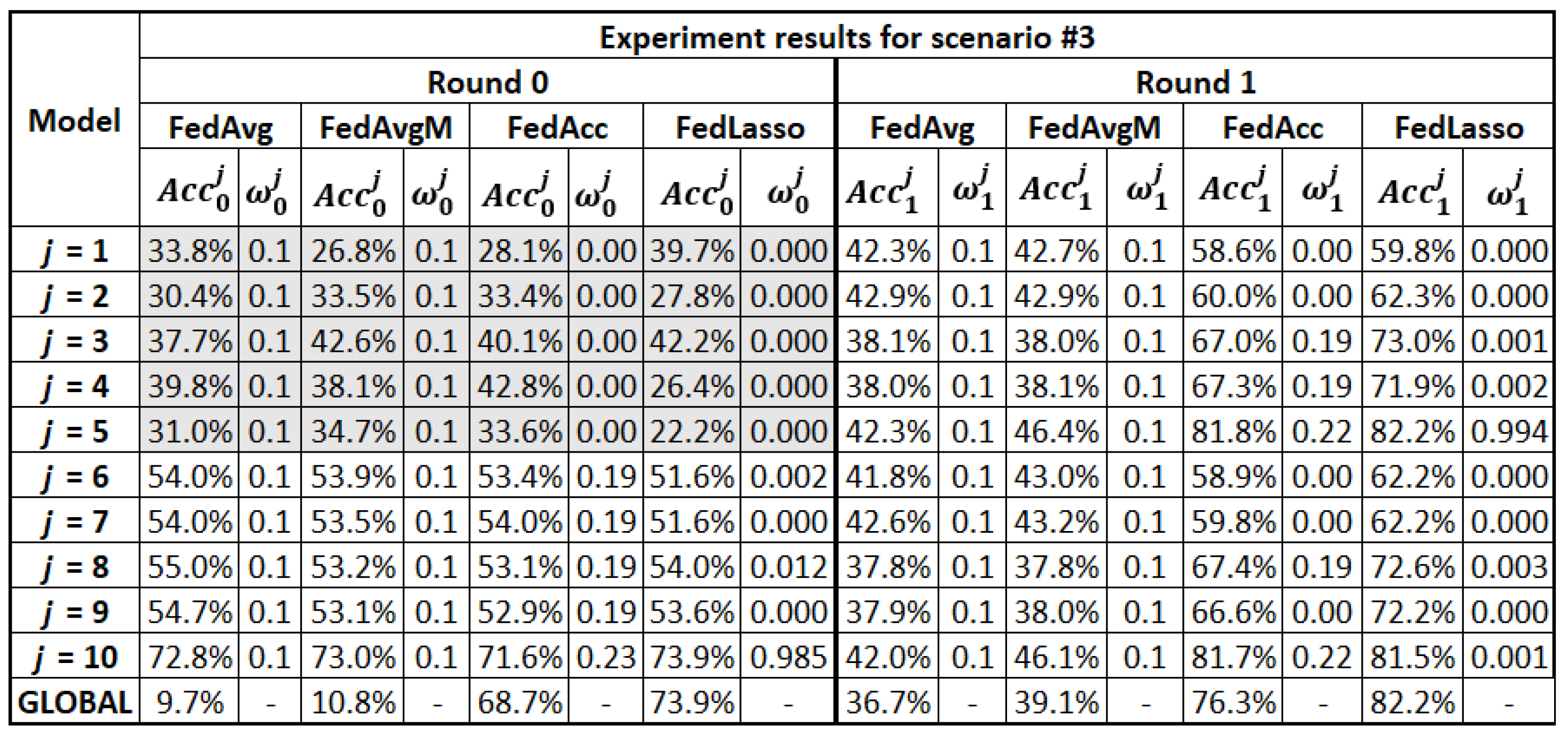
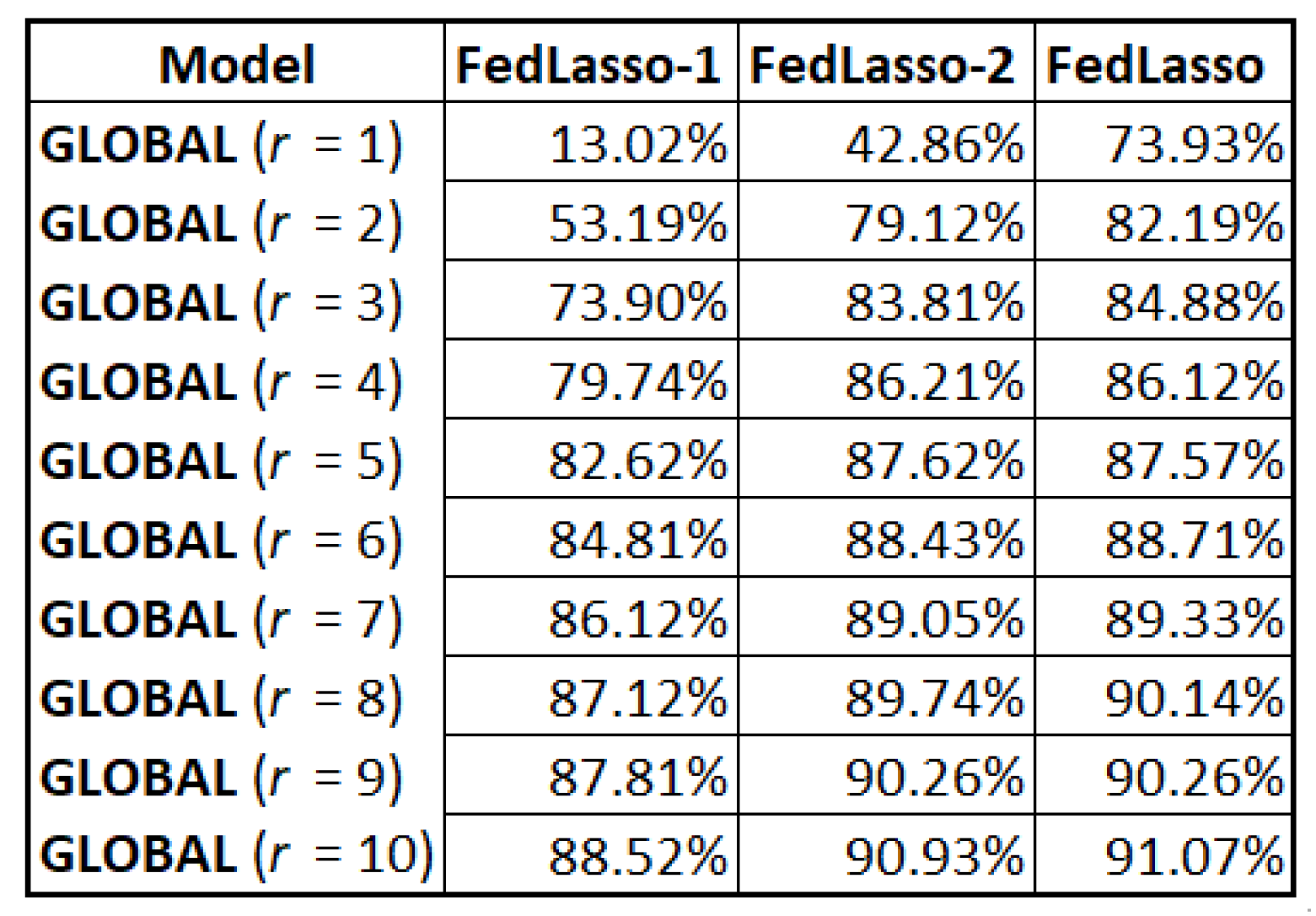
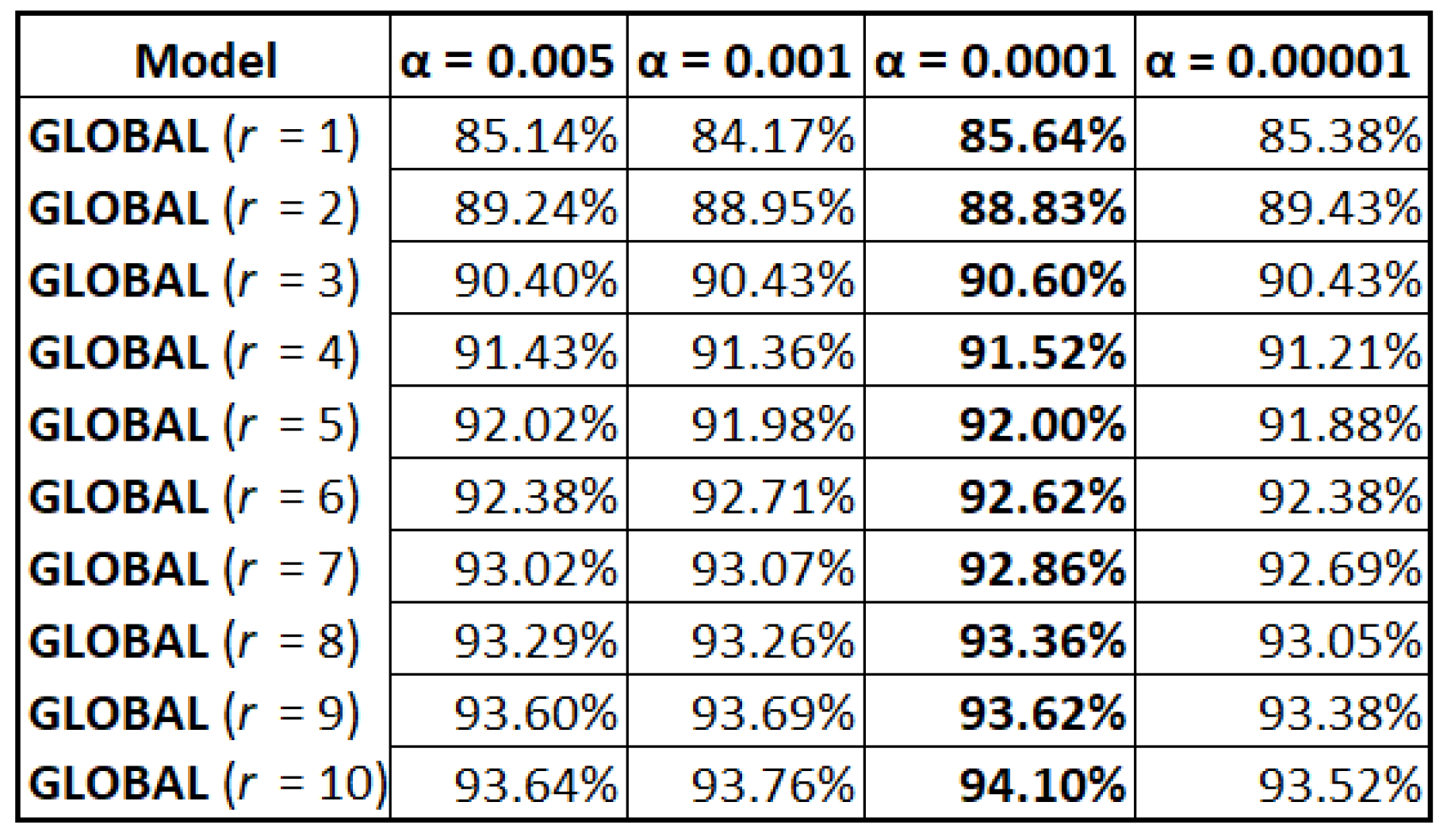
| Parameter | Description |
|---|---|
| the size of a data set | |
| R | the number of communication rounds |
| C | the total number of clients connected to the server |
| r | index for iterating the communication rounds |
| j | index for iterating the clients |
| the subset of active clients during the rth communication round () | |
| the training data set used by the jth client | |
| the total number of samples used by all active clients for training during the rth communication round () | |
| the total number of epochs used by the jth client | |
| k | index for iterating the training epochs |
| the learning rate used by the jth client | |
| J | the loss function adopted for training |
| the initial parameters of the global model | |
| , | the parameters of the global model at the beginning and end of the rth communication round, respectively |
| the weight assigned to the jth client during the rth communication round | |
| the momentum constant used by the server in the FedAvgM method | |
| the coefficients used in Lasso regression | |
| the intermediary coefficient computed before for client j at the rth communication round | |
| the accuracy of the client j at the end of the rth communication round | |
| the average accuracy of active clients at the end of the rth communication round |
Disclaimer/Publisher’s Note: The statements, opinions and data contained in all publications are solely those of the individual author(s) and contributor(s) and not of MDPI and/or the editor(s). MDPI and/or the editor(s) disclaim responsibility for any injury to people or property resulting from any ideas, methods, instructions or products referred to in the content. |
© 2023 by the authors. Licensee MDPI, Basel, Switzerland. This article is an open access article distributed under the terms and conditions of the Creative Commons Attribution (CC BY) license (https://creativecommons.org/licenses/by/4.0/).
Share and Cite
Bejenar, I.; Ferariu, L.; Pascal, C.; Caruntu, C.-F. Aggregation Methods Based on Quality Model Assessment for Federated Learning Applications: Overview and Comparative Analysis. Mathematics 2023, 11, 4610. https://doi.org/10.3390/math11224610
Bejenar I, Ferariu L, Pascal C, Caruntu C-F. Aggregation Methods Based on Quality Model Assessment for Federated Learning Applications: Overview and Comparative Analysis. Mathematics. 2023; 11(22):4610. https://doi.org/10.3390/math11224610
Chicago/Turabian StyleBejenar, Iuliana, Lavinia Ferariu, Carlos Pascal, and Constantin-Florin Caruntu. 2023. "Aggregation Methods Based on Quality Model Assessment for Federated Learning Applications: Overview and Comparative Analysis" Mathematics 11, no. 22: 4610. https://doi.org/10.3390/math11224610
APA StyleBejenar, I., Ferariu, L., Pascal, C., & Caruntu, C.-F. (2023). Aggregation Methods Based on Quality Model Assessment for Federated Learning Applications: Overview and Comparative Analysis. Mathematics, 11(22), 4610. https://doi.org/10.3390/math11224610








